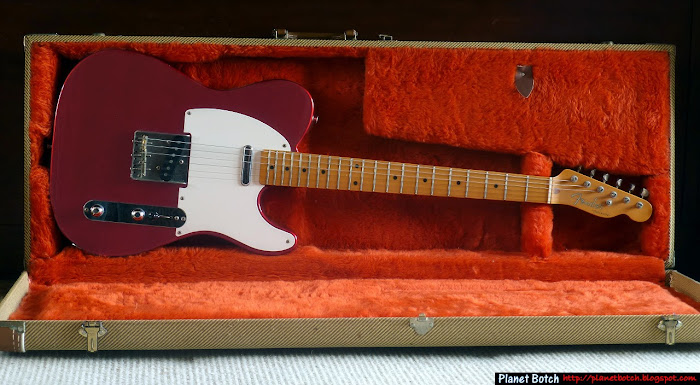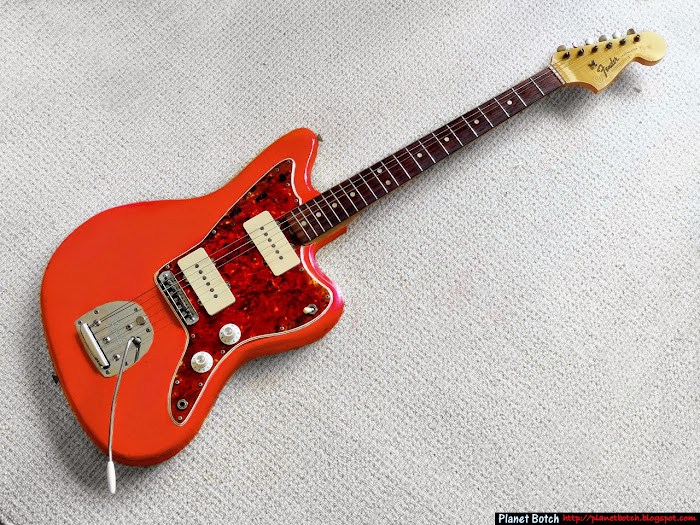
A 1950s design Fender Telecaster. The ultimate utilitarian guitar?
The man behind the Fender guitar brand – Leo Fender – is hailed as a genius. But whilst he was a somewhat off-the-wall inventor, he was not an engineer, and neither was he a guitarist. As someone whose life would not have been the same without the fantastic musical potential of Fender guitars, I’ve always acknowledged the truly iconic design brilliance of the Telecaster and Stratocaster. Indeed, they’re my two all-time favourite guitars by a wide margin. But in this post I want to explore an interesting notion that these two instruments may have been a fluke of good fortune, without which Leo Fender would today have been a footnote in rock and pop history, rather than the God he’s come to be considered…
In the mid to late 1940s, before the birth of the Fender Esquire/Broadcaster/Telecaster (I’ll just call it the Tele from now on), Leo Fender had spent a number of years repairing and making lap steel guitars. This brought him into close contact with cutting edge musicians and craftspeople. People who were themselves designing and inventing. People who had already invented the solid bodied electric guitar. Both Les Paul and Paul Bigsby had already employed the solid body concept in their guitar designs, and Fender knew the pair of them – very well.
It can't really be proved that Fender took the concept for his first solid bodied guitar from other people, and it is in any case fair to say that he wasn't specifically trying to major on solid body construction. He was really just trying to meet the needs of forward thinking guitarists using ideas he'd picked up or thought up in the lap steel business. His real concern was developing a guitar that was ideal for amplified use, and mass producing it economically and efficiently. Everything about the Telecaster conformed to that. But was its lasting appeal some great vision by Leo Fender, or was it a happy accident resulting from other people's input, and luck?...
It surprises a lot of people to learn that various key elements of Fender design were the work of employees, or the suggestions of working musicians – and not actually Leo Fender’s original ideas. The iconic body shape for the Tele, for example, was mapped out by George Fullerton. There’s also strong evidence that Fender originally had doubts about taking the Tele to market as a solid guitar. The final release could so easily have ended up hollow. So no, this wasn't a dramatic, spontaneously envisioned design. The spec was very fluid at the prototype stage, and could have gone a variety of ways. Right through the development of Fender’s classic instruments, you get a sense of Leo owing major selling points to those around him, and often getting things seriously wrong.
This isn’t to say that Leo wasn’t a brilliant thinker. He clearly was. But the more you investigate, the more you get the impression that the fantastic Fender guitars the world so widely celebrates, are actually quite different from what Leo had in mind when he conceived them. He didn’t initially visualise the Tele as a Tele. And neither did he visualise the Strat as a Strat. Some of the early engineering left a lot to be desired too. The classic old anecdote about three prototype Teles in a row failing to produce an output signal in a live demo situation epitomises the chaos of Fender’s quest to deliver a viable electric guitar.

An early 1960s design Fender Stratocaster. The Strat is very easily the most popular guitar design ever.
Among the other points which suggest Fender’s design radar was more hit and miss than is perhaps imagined, are the following…
Leo Fender’s original Stratocaster vibrato system was useless and had to be scrapped, along with all the tooling and machinery, costing the company $thousands, and delaying the introduction of the guitar by about six months. The excellent vibrato unit eventually employed was not Fender’s first choice and was only used in an emergency to avoid further delays in resolving the original unit’s problems.
Comfort contouring is deemed not to have been Leo Fender’s idea, and word is that he had to be pretty persuasively ‘convinced’, by Bill Carson, to implement it on the Strat.
Initially, dealers were unimpressed with the Stratocaster and were reticent to take it from Fender.
Much as the iconic look of Fender guitars (particularly the Strat) has come to be a major part of their success, Leo’s real interest was the practicality of the designs. How easy they were to make, to use, and to repair. Whether they functioned in accordance with musicians’ needs. It's very, very doubtful that Fender would have set out to create an instrument of great beauty, like the Strat. Its looks were owed in part to other people, in part to necessity, and in part to disaster (as in the case of the vibrato bridge).
Not only did appearance come second to Fender, he was also designing for musicians in the post-war decade, with very different needs from later rock stars who would eventually send the popularity of Fender guitars into orbit. Can it really be said that when the Strat was under development, Fender could have had any notion of what someone like Hendrix would later do with the guitar? It’s most unlikely, and that being the case, at least some degree of luck has to be factored into the guitar’s success story. It hasn’t taken over the world because of the people it was designed for. It’s taken over the world because of people, styles and uses Fender could never have foreseen.

The Fender Jaguar looks very cool, but if you've tried playing one you'll know that the slack, lifeless action, poor vibrato and over-complex switching/control would make the instrument impractical for a serious session player.
A number of other models released by the original Fender company, whilst successful at times, are not, technically, very good guitars. Both the Jazzmaster and the Jaguar – once top-of-the-line instruments – suffer from poor sustain and have issues with their vibratos which some believe to a lesser extent echo the problems with the original Strat trem.
So, was Fender really a genius?
THE VERDICT
If you look at success and how it works, you quickly discover that if someone flukes it, it’s almost impossible to repeat. The fact alone that both the Telecaster and the Stratocaster came to be considered, by many of the most influential guitarists who’ve ever lived, to be the best in the world, suggests that Fender’s success was unlikely to have been a fluke. With a fluke, one guitar, and that would have been that.

This Jazzmaster reminds us that whilst some Fender designs have proved to be flawed in the longer term, the company innovated at a level other companies would never dare. Even the in-ya-face custom colour was something more conservative guitar manufacturers would not previously entertain trying.
Fender invented and produced innovative guitars with totally out-there features which, even if not always his own idea, were an uncharted commercial risk. But that’s not all he invented and produced. Leo and his original company also brought the electric bass to the mass market, once again, in a form that was bang on the nail as soon as it hit the streets. Then there were the amplifiers. Even today, vintage Fender amps are some of the most beautiful sounding guitar combos ever. That’s always going to be a subjective opinion, obviously, but it’s true for a lot of people, and a wide array of subsequent smash hits in the amp world have really only been updates on the original Fender design.
I think Leo Fender was a genius, and was the kind of obsessive thinker/worker we’re all too short of in today’s world. He didn’t do it on his own, but importantly, he listened, intensely, to what people wanted, and he took customer feedback very, very seriously. He trusted the thoughts of people with talent – even if they weren’t famous or well known, and once again, that’s something very sadly lacking in modern business, where most companies merely copy existing formulae. As I’m sure I’ve said numerous times on this blog, it takes talent to recognise talent. Not only did Fender have it – he could also see it in others, and he surrounded himself with the right people. True, he got things wrong. But to get so much right, innovating at a complete tangent across multiple ranges of musicians’ tools, is not possible unless you’re a world-class inventor and entrepreneur. No one else has achieved what Leo Fender achieved in the world of guitars. A one-hit wonder he certainly wasn't.

